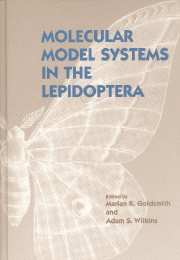Book contents
- Frontmatter
- Contents
- List of contributors
- Preface
- 1 A brief history of Lepidoptera as model systems
- 2 Genetics of the silkworm: revisiting an ancient model system
- 3 Mobile elements of lepidopteran genomes
- 4 Lepidopteran phytogeny and applications to comparative studies of development
- 5 A summary of lepidopteran embryogenesis and experimental embryology
- 6 Roles of homeotic genes in the Bombyx body plan
- 7 Chorion genes: an overview of their structure, function, and transcriptional regulation
- 8 Chorion genes: molecular models of evolution
- 9 Regulation of the silk protein genes and the homeobox genes in silk gland development
- 10 Control of transcription of Bombyx mori RNA polymerase III
- 11 Hormonal regulation of gene expression during lepidopteran development
- 12 Lepidoptera as model systems for studies of hormone action on the central nervous system
- 13 Molecular genetics of moth olfaction: a model for cellular identity and temporal assembly of the nervous system
- 14 Molecular biology of the immune response
- 15 Engineered baculoviruses: molecular tools for lepidopteran developmental biology and physiology and potential agents for insect pest control
- 16 Epilogue: Lepidopterans as model systems – questions and prospects
- References
- Index
1 - A brief history of Lepidoptera as model systems
Published online by Cambridge University Press: 23 November 2009
- Frontmatter
- Contents
- List of contributors
- Preface
- 1 A brief history of Lepidoptera as model systems
- 2 Genetics of the silkworm: revisiting an ancient model system
- 3 Mobile elements of lepidopteran genomes
- 4 Lepidopteran phytogeny and applications to comparative studies of development
- 5 A summary of lepidopteran embryogenesis and experimental embryology
- 6 Roles of homeotic genes in the Bombyx body plan
- 7 Chorion genes: an overview of their structure, function, and transcriptional regulation
- 8 Chorion genes: molecular models of evolution
- 9 Regulation of the silk protein genes and the homeobox genes in silk gland development
- 10 Control of transcription of Bombyx mori RNA polymerase III
- 11 Hormonal regulation of gene expression during lepidopteran development
- 12 Lepidoptera as model systems for studies of hormone action on the central nervous system
- 13 Molecular genetics of moth olfaction: a model for cellular identity and temporal assembly of the nervous system
- 14 Molecular biology of the immune response
- 15 Engineered baculoviruses: molecular tools for lepidopteran developmental biology and physiology and potential agents for insect pest control
- 16 Epilogue: Lepidopterans as model systems – questions and prospects
- References
- Index
Summary
Introduction
Throughout the twentieth century, the Lepidoptera, especially moths, have played important roles in fundamental studies in physiology, especially endocrinologic phenomena, and in biochemistry. Increasingly, they are also finding use in studies of biological development. Unfortunately, the recent resurgence of Drosophila melanogaster as the insect species par excellence for developmental analyses (see Lawrence, 1992) has seemingly eclipsed both past and current work on Lepidoptera. This book is intended, therefore, in part, to act as a counter, even an antidote, to the Drosophila centered view of insect biology. In particular, this introductory chapter is designed both to remind the reader of the special value of the Lepidoptera as model systems and to help preserve our knowledge of key discoveries in this field, discoveries whose general implications extend far beyond the particular organisms under study. The chapters that follow emphasize the streams of contemporary research that have flowed from these beginnings and, we hope, convey the breadth and intrinsic interest of lepidopteran biology today.
In taking stock of the origins of lepidopteran research, one can discern three distinct kinds of initial interest. The first was inspired directly by the beauty and variety of lepidopteran species, in particular, by the variety of wing color patterns. This variety has been and continues to be important in studies of systematics and evolution and in the elaboration of ideas about pattern formation (reviewed in Nijhout, 1991). The detailed analysis of the pigments that decorate Lepidoptera was also important in stimulating research in another direction, in spawning major areas of bio-organic chemistry (reviewed in Kayser, 1985).
The second aspect of Lepidoptera that has favored their use as biological model systems is the large body size of certain species and their amenability to surgical manipulation.
- Type
- Chapter
- Information
- Molecular Model Systems in the Lepidoptera , pp. 1 - 20Publisher: Cambridge University PressPrint publication year: 1995
- 10
- Cited by

